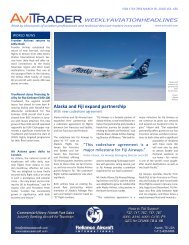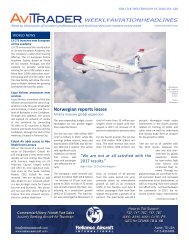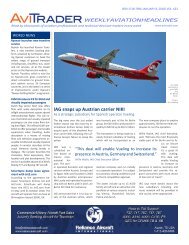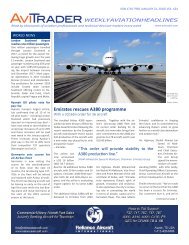AviTrader_Monthly_MRO_e-Magazine_2017-06
AviTrader_Monthly_MRO_e-Magazine_2017-06
AviTrader_Monthly_MRO_e-Magazine_2017-06
Create successful ePaper yourself
Turn your PDF publications into a flip-book with our unique Google optimized e-Paper software.
Lufthansa Consulting<br />
39<br />
Despite these limitations, most airlines already have the necessary data<br />
available to take the leap towards predictive maintenance, thanks to<br />
the high amount of data generated by sensors and monitoring devices.<br />
Implementing CBM and using data prognostics for the maintenance<br />
organization can be challenging due to resource constraints.<br />
What they need is a clear roadmap and implementation strategy.<br />
The roadmap towards predictive maintenance<br />
• First of all, any stakeholders involved in the maintenance process,<br />
including vendors and IT system providers, need to be identified. Furthermore,<br />
without a capable system provider, an efficient management<br />
of predictive maintenance is not feasible<br />
• Next, all components / systems that need to be closely monitored<br />
must be evaluated. Components / systems that are the most critical<br />
to operations. “No-go items” for which any failure could result in an<br />
AOG should be included, such as components / systems with a strong<br />
history of failure and the associated heavy costs.<br />
• A robust data acquisition layer must be developed so that real-time<br />
physical characteristics (e.g. vibration, temperature or pressure etc.)<br />
are transmitted through wireless sensor systems or communication<br />
technologies such as ACARS or SATCOM. Data volume, frequency<br />
and sensibility as well as cost impact should be considered in order to<br />
choose the most adaptable solution for data transmission, processing<br />
and data alignment from multiple devices. Additionally, data storage<br />
capabilities need to be taken into consideration.<br />
• After the vast amount of unstructured data has been transmitted and<br />
segregated, it enters the testing phase. Alongside CBM, the predictive<br />
system is based on sophisticated mathematical prognostics that<br />
emphasise leading indicators of failures and compare real-time data<br />
against historical trends. Key outputs of this system are the detection<br />
of abnormalities and a time-phased estimated probability of failure.<br />
• The system must be configured in such way that when a defect is<br />
forecast, a case is automatically created and an alert generated as<br />
soon as possible so that the airline and the <strong>MRO</strong> company have time<br />
to further process and execute a maintenance action. The most appropriate<br />
solution should be automatically proposed or quickly deduced<br />
by engineers responsible for monitoring the indicators. On the basis<br />
of their analysis, maintenance teams receive engineering orders that<br />
a maintenance action is needed in order to avoid any further operational<br />
consequences.<br />
Implementing a smooth predictive maintenance system needs much more than a “one size fits all” solution<br />
The predictive strategy must be customized to the specific needs of the airline / <strong>MRO</strong>.<br />
A tailored solution<br />
• Mathematical models of the predictive system should be customised<br />
for the company (airline/ <strong>MRO</strong>) and fine-tuned over time. The component<br />
or aircraft system performance evolves along its life cycle. The objective<br />
is to create models that are capable of detecting all upcoming<br />
defects but not sensitive to the point at which they would generate false<br />
alerts. In order to avoid the generation of false alerts, the monitoring<br />
process has to be calibrated.<br />
• Predictive modeling outcomes can incorporate other useful business<br />
information. For example, by analysing financial data with sensor<br />
data, the business impact of various potential failures can be assessed,<br />
and maintenance alerts prioritized appropriately.<br />
• The predictive maintenance approach leads to greater integration in<br />
the establishment of a “data democracy”: virtually any collaborative<br />
team or employee should be able to access a web-based interface that<br />
consolidates data sources from multiple monitoring systems as well as,<br />
for example, maintenance schedules, in order to make data-enhanced<br />
decisions. Data from sensors must be combined with the <strong>MRO</strong> ERP, in<br />
a reliability-centric enterprise data model.<br />
or theft. The processing of data in the monitoring devices themselves<br />
or data transmission to the ground are the major points of security<br />
vulnerabilities. Data and information can be secured with encrypting<br />
algorithms. After the data has been aggregated, security can be ensured<br />
through the implementation of a trusted platform module.<br />
Lufthansa Consulting focuses on helping their clients to embrace<br />
the power of analytics to improve their maintenance processes. The<br />
structured approach enables our clients to implement such a strategy<br />
and encourages them to take the leap towards a high level of correct<br />
maintenance decisions, made rapidly and involving less expense, and<br />
ultimately to increase the longevity and reliability of their assets and<br />
raise their operational profitability. With the support of Lufthansa Consulting,<br />
you too can take the bold step towards Predictive Maintenance,<br />
a truly competitive method for airlines and <strong>MRO</strong> companies.<br />
• Aircraft operators and <strong>MRO</strong> companies must preserve full rights to<br />
their data, including the option to share it with their suppliers. The<br />
system must also be firmly protected against any third-party influence<br />
<strong>AviTrader</strong> <strong>MRO</strong> - June <strong>2017</strong>

















